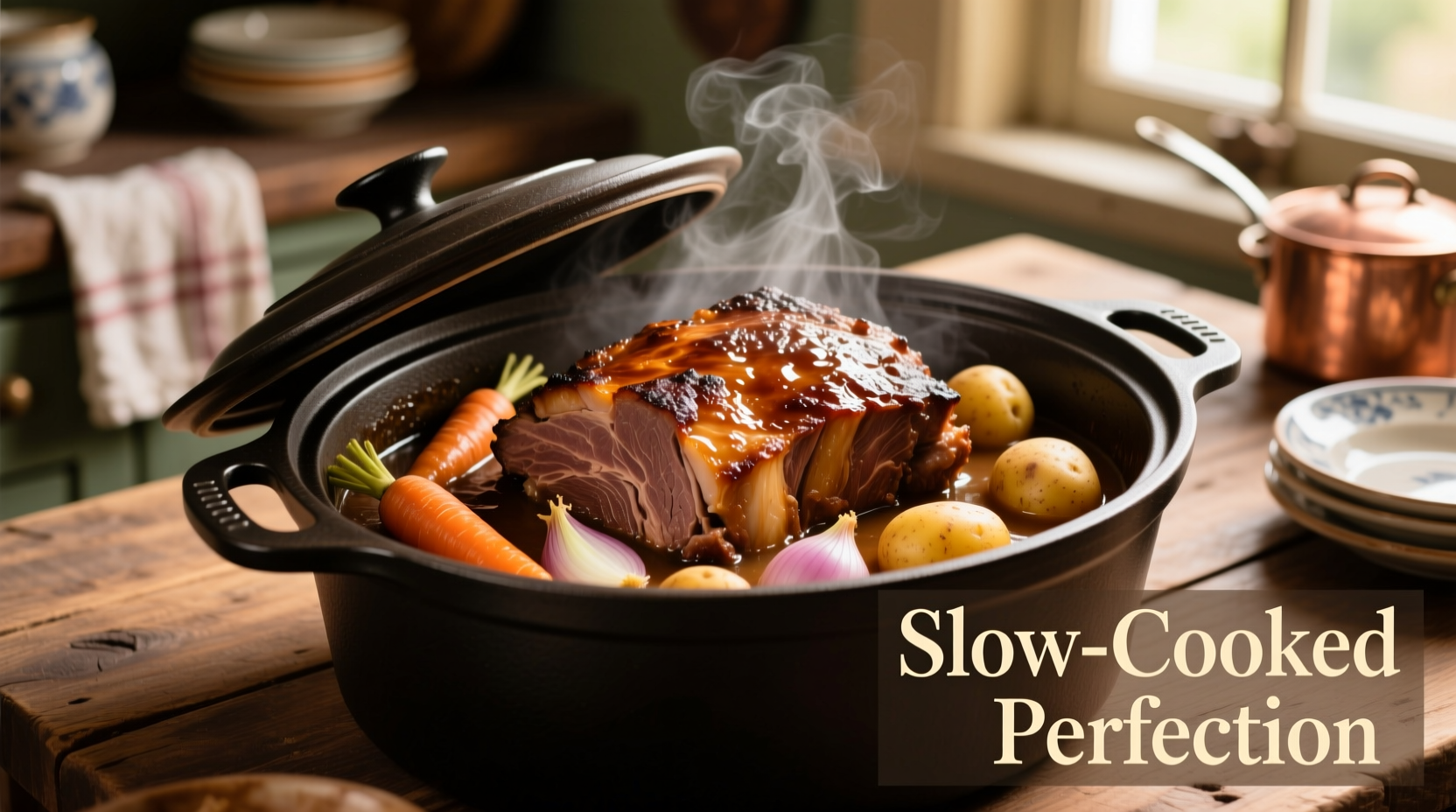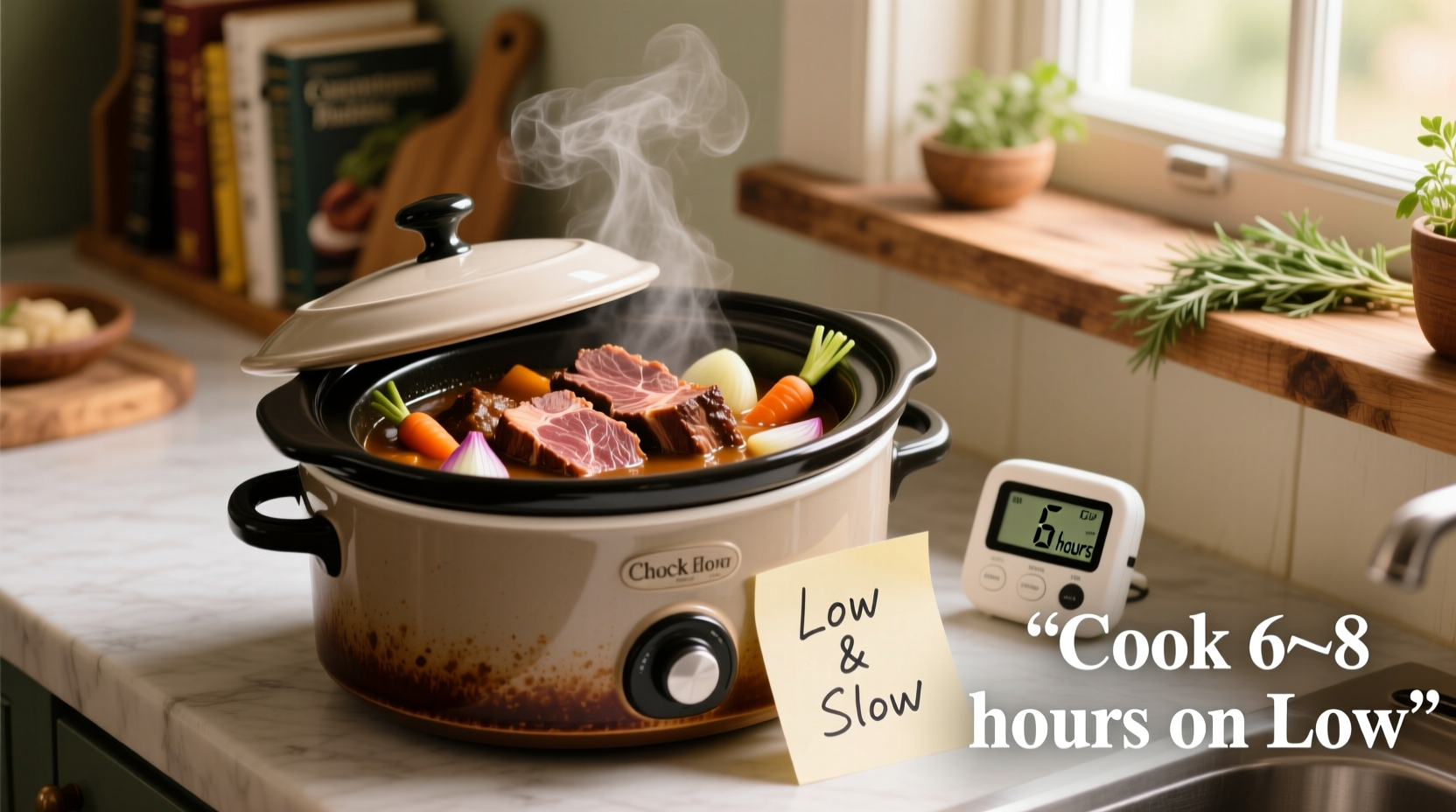For a standard 3-4 pound chuck roast in a crock pot, cook on LOW for 8-10 hours or on HIGH for 5-6 hours until fork-tender. The internal temperature should reach 195°F (90°C) for optimal tenderness, as recommended by USDA food safety guidelines.
Nothing beats the aroma of a perfectly cooked chuck roast filling your kitchen after a slow day of tenderizing in the crock pot. As someone who's tested hundreds of slow-cooked roasts, I can tell you the exact timing makes all the difference between melt-in-your-mouth perfection and tough, chewy disappointment. This guide delivers science-backed cooking times that work consistently, whether you're preparing a classic pot roast or experimenting with global flavors.
Why Chuck Roast Needs Slow Cooking
Chuck roast comes from the shoulder area of the cow—a heavily exercised muscle packed with connective tissue. This cut transforms from tough to tender through slow cooking, as collagen breaks down into gelatin. The magic happens between 160°F-205°F (71°C-96°C), which is why low-and-slow methods work best. Rushing the process by cranking the heat creates stringy, dry meat.
| Chuck Roast Weight | LOW Setting Time | HIGH Setting Time | Doneness Indicator |
|---|---|---|---|
| 2-3 pounds | 7-8 hours | 4-5 hours | Fork slides in easily |
| 3-4 pounds | 8-10 hours | 5-6 hours | Meat pulls apart with light pressure |
| 4-5 pounds | 9-11 hours | 6-7 hours | Shreds effortlessly when twisted |
Preparation Steps for Best Results
Searing your chuck roast before slow cooking creates complex flavor compounds through the Maillard reaction. Pat the meat dry, then sear in hot oil for 3-4 minutes per side until deeply browned. This step isn't mandatory but significantly improves flavor depth. For optimal results, leave approximately 1/4 inch of fat cap intact—it bastes the meat during cooking.

Science-Backed Cooking Timeline
Understanding the transformation timeline helps prevent under or overcooking:
- 0-2 hours: Surface temperature rises; minimal tenderness change
- 2-4 hours: Collagen begins breaking down; meat remains firm
- 4-6 hours: Connective tissue softens significantly; HIGH setting reaches this stage
- 6-8 hours: Optimal tenderness zone for LOW setting; collagen fully converts to gelatin
- 8+ hours: Risk of drying out if liquid evaporates; monitor closely
According to USDA Food Safety guidelines, chuck roast must reach a minimum internal temperature of 145°F (63°C) for safety, but for proper tenderness you'll need to continue cooking to 195°F (90°C). This higher temperature ensures complete collagen breakdown—a critical detail many home cooks miss when following basic food safety charts.
Troubleshooting Common Issues
Problem: Meat remains tough after recommended cooking time
Solution: Continue cooking in 30-minute increments. This often happens with larger roasts or when starting with meat straight from the refrigerator. The University of Minnesota Extension recommends adding 1-2 hours for roasts over 4 pounds.
Problem: Excess liquid in the pot
Solution: Remove the roast, then simmer cooking liquid uncovered for 15-20 minutes to reduce and concentrate flavors. A 3:1 meat-to-liquid ratio prevents this issue—use no more than 1¼ cups liquid for a 3-4 pound roast.
Flavor Variations That Work Every Time
Once you've mastered basic timing, experiment with these proven variations:
- Classic Pot Roast: Combine 1 cup beef broth, 2 tbsp tomato paste, 4 garlic cloves, and fresh thyme. Add carrots and potatoes after 6 hours on LOW.
- Mexican Barbacoa: Use 1 cup cola, 3 chipotle peppers in adobo, and 2 tbsp cumin. Cook 8 hours on LOW, then shred and broil for crispy edges.
- Asian Fusion: Simmer in 1 cup coconut milk, 1/4 cup soy sauce, and 3 star anise pods. Add bamboo shoots during the last 2 hours.
Safety and Storage Guidelines
Always verify doneness with an instant-read thermometer—the fork-tender test alone isn't sufficient for food safety. Leftovers should be cooled within 2 hours and stored in airtight containers. The National Center for Home Food Preservation confirms slow-cooked meats remain safe for 3-4 days refrigerated or 2-3 months frozen. When reheating, bring to 165°F (74°C) internal temperature.
Pro Tips for Consistent Success
- Never lift the lid during cooking—each peek adds 20-30 minutes to total time
- Trim excess hard fat, but keep marbling for flavor and moisture
- Add acidic ingredients (tomatoes, wine) early to help tenderize
- Cook vegetables separately if you prefer firmer texture
- Rest the roast 15 minutes before slicing to redistribute juices











 浙公网安备
33010002000092号
浙公网安备
33010002000092号 浙B2-20120091-4
浙B2-20120091-4